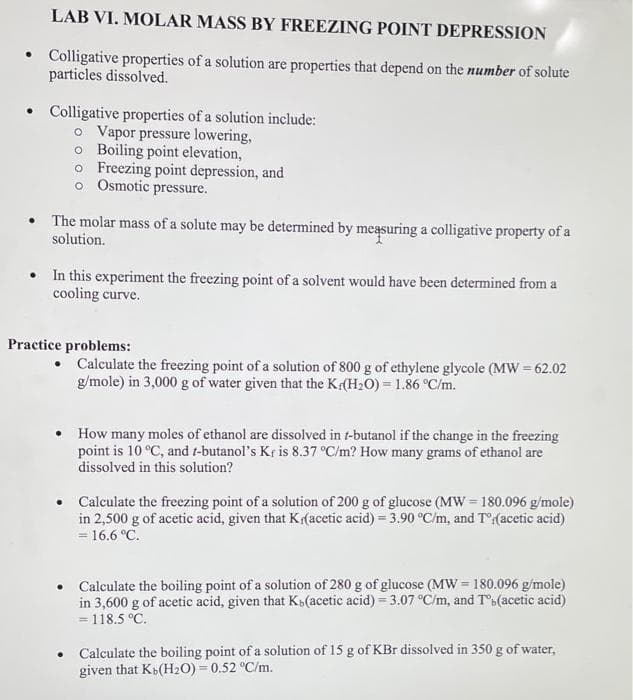EPRESSION - Colligative properties of a solution are properties that depend on the number of solute particles dissolved. - Colligative properties of a solution include: o Vapor pressure lowering, o Boiling point elevation, o Freezing point depression, and o Osmotic pressure. • The molar mass of a solute may be determined by measuring a colligative property of a solution. • In this experiment the freezing point of a solvent would have been determined from a cooling curve. actice problems: • Calculate the freezing point of a solution of 800 g of ethylene glycole (MW = 62.02 g/mole) in 3,000 g of water given that the K(H2O) = 1.86 °C/m. • How many moles of ethanol are dissolved in t-butanol if the change in the freezing point is 10 °C, and t-butanol's Kr is 8.37 °C/m? How many grams of ethanol are dissolved in this solution? Calculate the freezing point of a solution of 200 g of glucose (MW = 180.096 g/mole) in 2,500 g of acetic acid, given that K(acetic acid) = 3.90 °C/m, and T (acetic acid) = 16.6 °C. • Calculate the boiling point of a solution of 280 g of glucose (MW = 180.096 g/mole) in 3,600 g of acetic acid, given that K»(acetic acid) = 3.07 °C/m, and T'b(acetic acid) = 118.5 °C. • Calculate the boiling point of a solution of 15 g of KBr dissolved in 350 g of water, given that KB(H2O) = 0.52 °C/m.
EPRESSION - Colligative properties of a solution are properties that depend on the number of solute particles dissolved. - Colligative properties of a solution include: o Vapor pressure lowering, o Boiling point elevation, o Freezing point depression, and o Osmotic pressure. • The molar mass of a solute may be determined by measuring a colligative property of a solution. • In this experiment the freezing point of a solvent would have been determined from a cooling curve. actice problems: • Calculate the freezing point of a solution of 800 g of ethylene glycole (MW = 62.02 g/mole) in 3,000 g of water given that the K(H2O) = 1.86 °C/m. • How many moles of ethanol are dissolved in t-butanol if the change in the freezing point is 10 °C, and t-butanol's Kr is 8.37 °C/m? How many grams of ethanol are dissolved in this solution? Calculate the freezing point of a solution of 200 g of glucose (MW = 180.096 g/mole) in 2,500 g of acetic acid, given that K(acetic acid) = 3.90 °C/m, and T (acetic acid) = 16.6 °C. • Calculate the boiling point of a solution of 280 g of glucose (MW = 180.096 g/mole) in 3,600 g of acetic acid, given that K»(acetic acid) = 3.07 °C/m, and T'b(acetic acid) = 118.5 °C. • Calculate the boiling point of a solution of 15 g of KBr dissolved in 350 g of water, given that KB(H2O) = 0.52 °C/m.
Chapter80: Crystallization: Purification Of Solids
Section: Chapter Questions
Problem 1P
Related questions
Question

Transcribed Image Text:LAB VI. MOLAR MASS BY FREEZING POINT DEPRESSION
• Colligative properties of a solution are properties that depend on the number of solute
particles dissolved.
• Colligative properties of a solution include:
o Vapor pressure lowering,
o Boiling point elevation,
o Freezing point depression, and
o Osmotic pressure.
• The molar mass of a solute may be determined by measuring a colligative property of a
solution.
• In this experiment the freezing point of a solvent would have been determined from a
cooling curve.
Practice problems:
• Calculate the freezing point of a solution of 800 g of ethylene glycole (MW = 62.02
g/mole) in 3,000 g of water given that the K(H2O) = 1.86 °C/m.
• How many moles of ethanol are dissolved in t-butanol if the change in the freezing
point is 10 °C, and t-butanol's Kr is 8.37 °C/m? How many grams of ethanol are
dissolved in this solution?
Calculate the freezing point of a solution of 200 g of glucose (MW = 180.096 g/mole)
in 2,500 g of acetic acid, given that Kr(acetic acid) = 3.90 °C/m, and T(acetic acid)
= 16.6 °C.
Calculate the boiling point of a solution of 280 g of glucose (MW = 180.096 g/mole)
in 3,600 g of acetic acid, given that Kb(acetic acid) = 3.07 °C/m, and T(acetic acid)
= 118.5 °C.
Calculate the boiling point of a solution of 15 g of KBr dissolved in 350 g of water,
given that K(H2O) = 0.52 °C/m.
Expert Solution
This question has been solved!
Explore an expertly crafted, step-by-step solution for a thorough understanding of key concepts.
This is a popular solution!
Trending now
This is a popular solution!
Step by step
Solved in 2 steps

Knowledge Booster
Learn more about
Need a deep-dive on the concept behind this application? Look no further. Learn more about this topic, chemistry and related others by exploring similar questions and additional content below.Recommended textbooks for you

EBK A SMALL SCALE APPROACH TO ORGANIC L
Chemistry
ISBN:
9781305446021
Author:
Lampman
Publisher:
CENGAGE LEARNING - CONSIGNMENT

Chemistry & Chemical Reactivity
Chemistry
ISBN:
9781337399074
Author:
John C. Kotz, Paul M. Treichel, John Townsend, David Treichel
Publisher:
Cengage Learning

Chemistry & Chemical Reactivity
Chemistry
ISBN:
9781133949640
Author:
John C. Kotz, Paul M. Treichel, John Townsend, David Treichel
Publisher:
Cengage Learning

EBK A SMALL SCALE APPROACH TO ORGANIC L
Chemistry
ISBN:
9781305446021
Author:
Lampman
Publisher:
CENGAGE LEARNING - CONSIGNMENT

Chemistry & Chemical Reactivity
Chemistry
ISBN:
9781337399074
Author:
John C. Kotz, Paul M. Treichel, John Townsend, David Treichel
Publisher:
Cengage Learning

Chemistry & Chemical Reactivity
Chemistry
ISBN:
9781133949640
Author:
John C. Kotz, Paul M. Treichel, John Townsend, David Treichel
Publisher:
Cengage Learning

Principles of Modern Chemistry
Chemistry
ISBN:
9781305079113
Author:
David W. Oxtoby, H. Pat Gillis, Laurie J. Butler
Publisher:
Cengage Learning

Chemical Principles in the Laboratory
Chemistry
ISBN:
9781305264434
Author:
Emil Slowinski, Wayne C. Wolsey, Robert Rossi
Publisher:
Brooks Cole

Chemistry: Principles and Reactions
Chemistry
ISBN:
9781305079373
Author:
William L. Masterton, Cecile N. Hurley
Publisher:
Cengage Learning